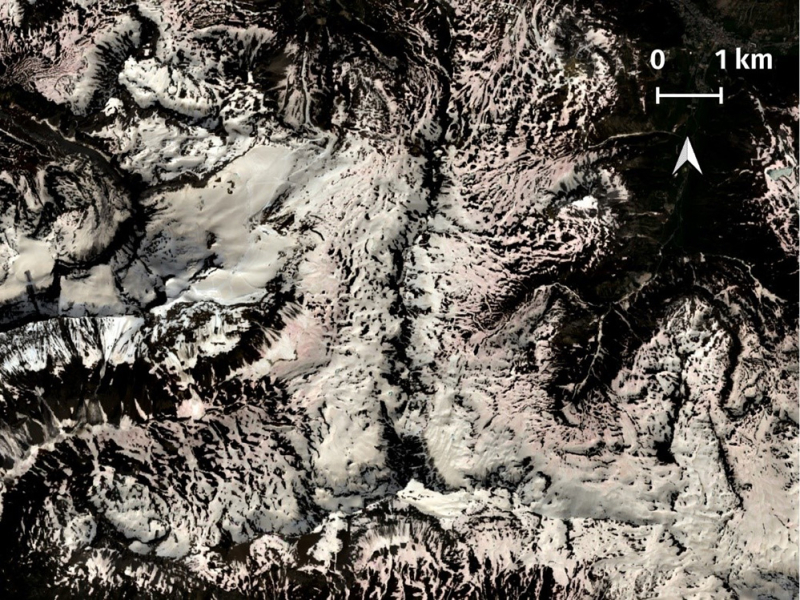The conditions that cause snow algae blooms are poorly understood.
In late spring in alpine meadows, the surface of the snow sometimes becomes colored by microscopic particles, which accelerate melting. The colors of the snow cover may vary. Ochre shades are often due to deposits of Saharan sand from the previous winter. More or less scattered red patches can also be seen. These spots correspond to clusters of microalgae, composed of microscopic cells barely visible to the naked eye, which have proliferated in very large numbers in the snow, forming what is known as a “bloom”. In the Alps, the dominant species of snow algae is
Sanguina nivaloides. Red snows are often called watermelon snows. The red color comes from a carotenoid molecule that
Sanguina nivaloides accumulates, called astaxanthin. Despite major recent efforts to understand its biology,
Sanguina nivaloides remains mysterious and raises many questions. Where are blooms likely to occur? Are they always in the same places, linked to a reservoir of algae that persists from year to year, or are they detected in different places following a dispersal process, with airborne spreading of microalgae, for example? Why do red blooms appear at this time of year? Are blooms more frequent as a result of climate change? What impact will these algae have on snow cover in the decades to come?
Satellite tracking to better understand the origin of blooms.
Scientists from different disciplines within the AlpAlga consortium (https://alpalga.fr/), including the Snow Study Center (Météo-France/CNRS) and IRIG (CEA/DRF), have coordinated their efforts and knowledge in an attempt to answer these questions. Using satellite images captured by Sentinel-2, and using classification methods to exclude coloration caused by Saharan sand deposits, they were able to detect the carotenoid pigment astaxanthin, which colors snow, and map the occurrence of intense blooms in the European Alps over a five-year period. Algal blooms appear at altitudes of between 2,000 and 3,000 meters above sea level (a. s. l.), in the Vanoise, Swiss Valais and Italian Ruitor regions, among others. On an Alpine scale, they cover up to 1.3% of the surface area above 1,800 meters a.s.l.. This analysis has led to the first “atlas” of red snow in the European Alps (https://umap.openstreetmap.fr/fr/map/red-algae-in-alpine-snow_936611#9/45.3454/7.2372). Using detailed simulations of the snowpack, this work has also made it possible to identify the very specific conditions, previously unknown, that are most correlated with the appearance of blooms. Blooms appear after sufficiently long periods of melting, of the order of 50 days, giving algae more time to develop in a snowpack full of liquid water. Blooms appear to occur year after year in the same areas, reinforcing the hypothesis of perennial reservoirs of microalgae, particularly in soils. Finally, this work has shown that blooms do not appear to develop on soils that remain frozen throughout the year, or permafrost. This confirms the sensitivity of Sanguina nivaloides to freezing, as measured in the laboratory, and reinforces the hypothesis that microalgae do not find snow an extreme environment, but rather a thermally stable and protective one.
Satellite view of red algae in alpine snow.
The impact of blooms on snowmelt. When blooms color the snow, the albedo decreases, increasing the amount of solar energy absorbed by the snowpack. The algae thus accelerate the melting of the snow on which they are found. Can this phenomenon have a significant impact on the scale of a mountain range? It has previously been shown in the Arctic, in Greenland in particular, that the presence of microalgae contributes significantly to the melting of glaciers. With the climate changing, scientists are now looking into the future of these blooms and their impact, particularly in the European Alps. To do so, they used climate change scenarios. Climate projections show that snow quantities and average melting times will decrease at low altitudes (around 1500 meters). However, projections at mid-altitude (around 2,500 meters), where the algae studied are found, are more moderate: melting times and snow quantities will decrease less rapidly than at low altitudes. This study therefore predicts that the frequency of blooms and their impact on snow should remain stable or decrease slightly by 2100.
 Figure :
Figure : Red snow visible by Satellite. Sentinel-2 image from 06/19/2018 in the Vanoise massif, France. Source : theia.cnes.fr
Laboratories:
Laboratoire de Physiologie Cellulaire et Végétale - LPCV (CNRS/CEA/INRAE/Univ. Grenoble Alpes)
CEA Grenoble
17 rue des Martyrs
38054 GRENOBLE CEDEX 9 - France
Centre National de Recherches Météorologiques / Centre d’étude de la Neige (CNRS/Météo-France)
1441 rue de la Piscine
38400 Saint-Martin d’Hères
Centre d’études spatiales de la biosphère - CESBIO (CNRS/Université Toulouse Paul Sabatier/IRD/CNES)
18 avenue Edouard Belin
31401 TOULOUSE CEDEX 9 - France